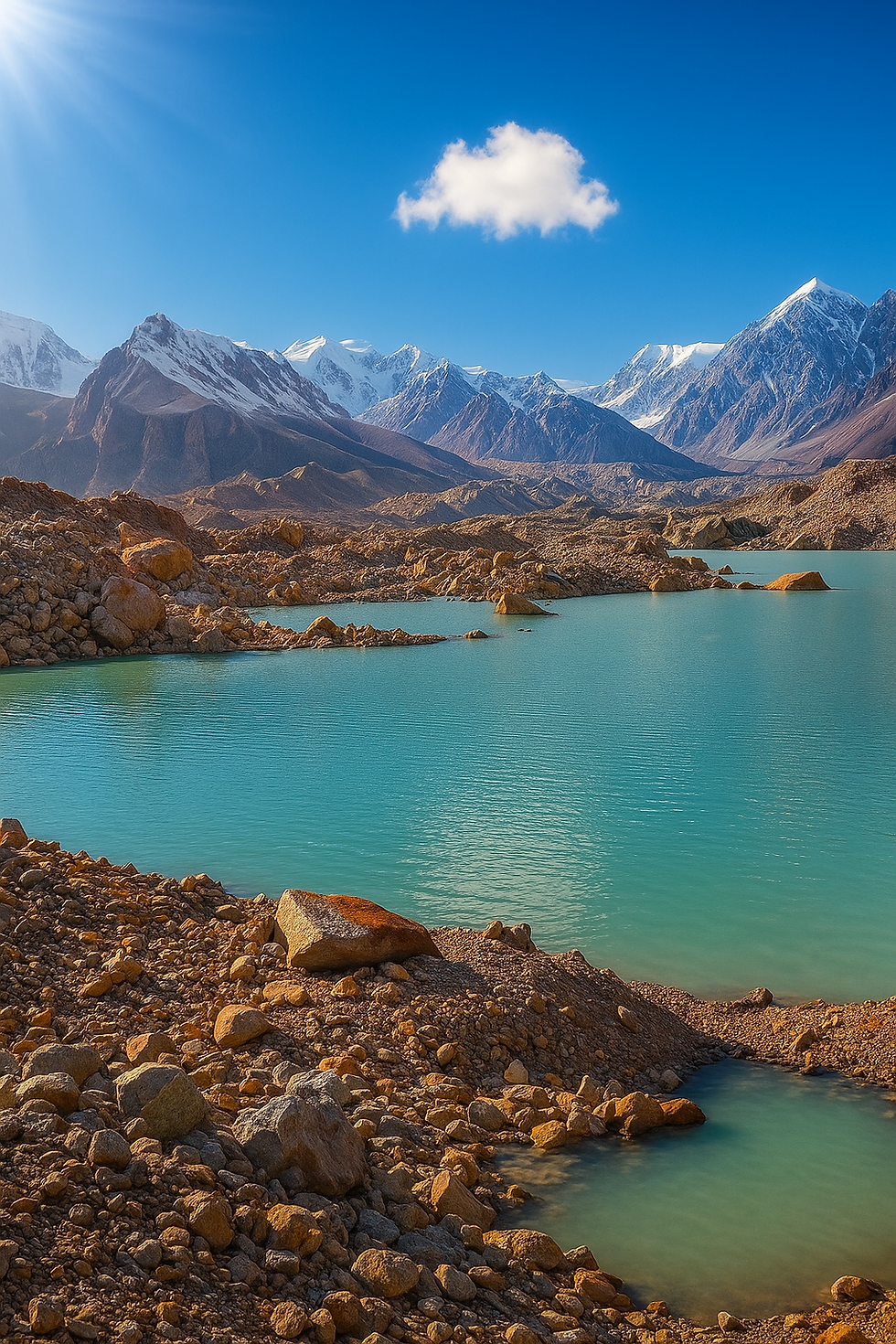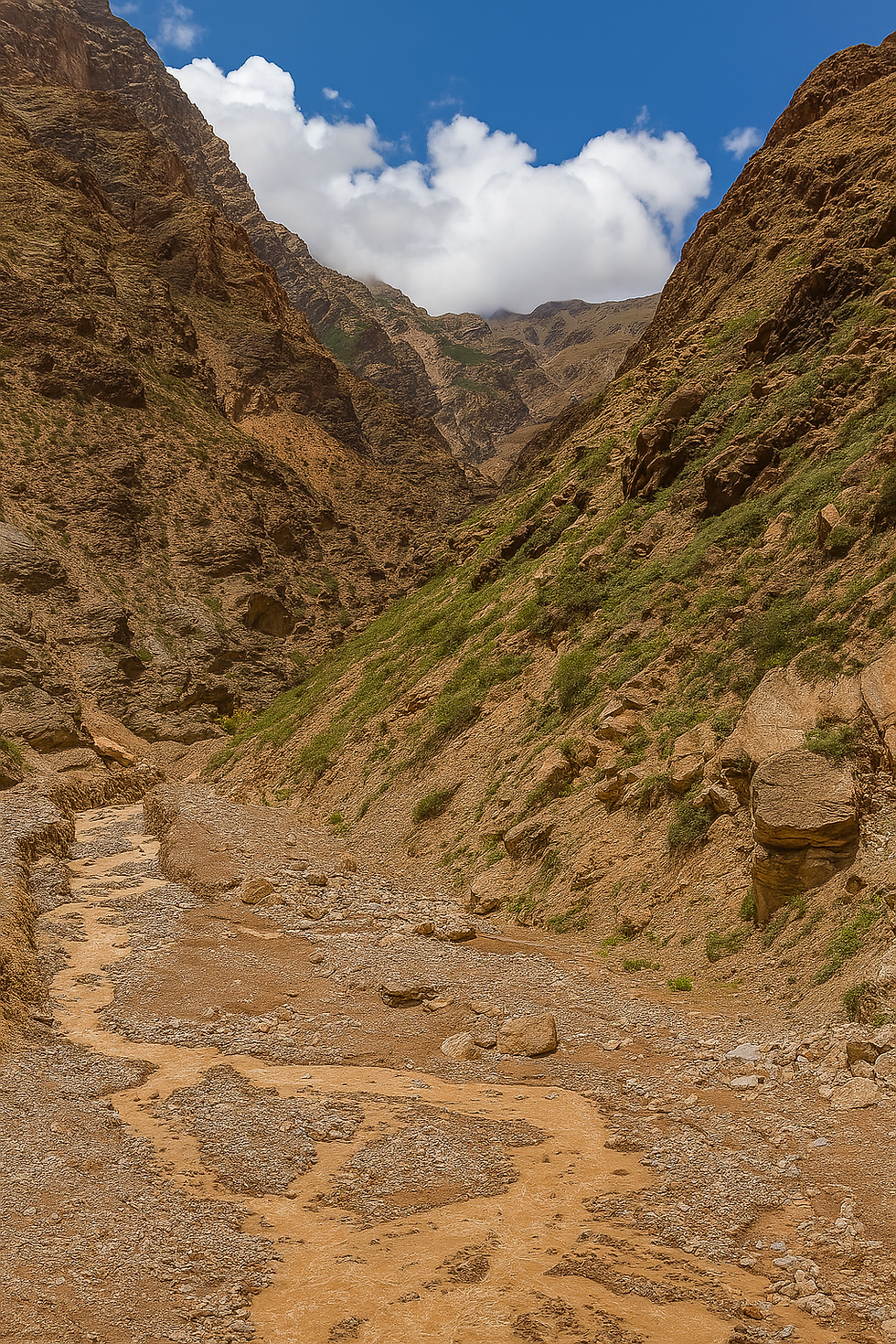Dhauliganga River - Uttarakhand | A Himalayan River of Significance
- Team Walking The Himalayas

- Jul 8
- 5 min read
Dhauliganga River – The Untamed Spirit of Uttarakhand
High in the snow-wrapped wilderness of Uttarakhand, where the sky meets icy peaks and the air smells of pine and reverence, a river is born. It is not just any river—it is the Dhauliganga, a wild, glacial force that tells a story older than maps, older than the hills it rushes through. If the Himalayas are the guardians of India’s spiritual and ecological soul, Dhauliganga is their living pulse—sometimes calm, often furious, but always sacred.

Chapter 1: Born of Ice and Silence
It all begins near the Niti Pass, where India ends and Tibet begins. Here, in the high Garhwal Himalayas, at an altitude where only the hardiest mountain goats dare roam, the Dhauliganga River takes its first breath. Melted ice from ancient glaciers trickles through crevices, gathering into a cold stream that winds through rock and moraine.
In these silent heights, no one hears the river’s beginning. No temples yet stand beside it, and no villages offer prayers to its waters. It flows untamed like a secret being whispered by the mountains.

Chapter 2: The River Finds Its Voice
As it descends, the Dhauliganga becomes louder, angrier, and more visible. It tears through gorges, smashing boulders into the sand, cutting valleys where none existed. The first villages it greets—Malari, Niti, and Gamshali—are ancient hamlets that have lived in harmony with the river for centuries.
The people here speak of the river like a living deity. “She’s like a mountain mother,” says an old woman in Malari, wrapping her shawl tighter. “She gives us water, beauty, fear, and sometimes punishment.”
It is in this region that the river begins its identity—not just as a waterway, but as a legend.
Chapter 3: Raini and the Cry of the Earth
Further downstream lies the quiet village of Raini. This is no ordinary village; it holds the legacy of Gaura Devi and the Chipko Movement, where women once hugged trees to save them from being felled. Here, the bond between people and nature is sacred, forged in defiance and love.
But the river, despite its beauty, is not gentle. In 2021, without warning, the Dhauliganga turned violent. A glacier high above broke loose, hurtling debris, ice, and fury into the valley. Within minutes, the landscape changed forever. A roaring wall of water devoured everything—bridges, roads, homes, hydro plants, and lives.
Raini was never the same again. But like the women of Chipko, the people stood strong. They rebuilt, remembered, and resumed. The river had screamed, but they had listened.

Chapter 4: The Confluence of Divinity
Not far from Raini, where the Dhauliganga meets the Rishiganga, the river turns westward, seemingly guided by a deeper instinct. Eventually, it arrives at a spiritually significant place: Vishnuprayag.
Here, the Dhauliganga merges with the Alaknanda River. The confluence is not just a geographical event—it is a sacred moment. In Hindu belief, the merging of two rivers is symbolic of life’s union with the divine.
Pilgrims bathe in the chilly water, their hands folded in reverence. It is said that sins dissolve here, and one leaves the confluence lighter, purer, and more aware of the universe’s great rhythms. The river, now transformed, continues its journey as part of the greater Ganga.
Chapter 5: The Power and the Price
The river’s might didn’t go unnoticed. Over time, men came with machines, blueprints, and promises of power. Hydropower dams rose in the valley—massive structures meant to harness the river’s energy.
Among them was the Tapovan-Vishnugad Hydropower Plant, a mega project built on dreams of electricity and economic growth. For a time, the project symbolized progress. Locals were given jobs, towns grew, and the hum of development filled the valley.
But Dhauliganga was never meant to be tamed.
The 2021 disaster devastated the dam, washing away lives and livelihoods. Workers were trapped, entire tunnels collapsed, and the river reminded everyone that nature when provoked, does not whisper—it roars.
Since then, debates have raged. Can such fragile zones truly support such massive development? What price must progress pay in a land shaped by gods and glaciers?
Chapter 6: The River in Two Worlds
Interestingly, Dhauliganga exists in two avatars. One flows through Garhwal, and another through Kumaon, where it emerges from the high Himalayas near Pithoragarh. This branch flows eastward, joining the Kali River, which forms the natural boundary between India and Nepal.
While the Garhwal Dhauliganga is known for its fury and religious importance, the Kumaon Dhauliganga is quieter, gentler, and lesser known. Yet the same ancient glaciers feed both, and both eventually become part of the mighty Ganga system.
In essence, the river lives two lives—one loud, one soft; one famous, one forgotten.

Chapter 7: Life Along the Banks
For the villagers of Uttarakhand, the Dhauliganga is more than a river—it is time itself.
Children bathe in its shallows during summer, their laughter echoing through cedar forests. Women fill copper pots at dawn, their reflections shimmering on the surface. Farmers pray before planting, hoping the river’s rhythm will bless the crops.
In winter, the river slows and hardens, just like life in the hills. But even when frozen, it pulses beneath the ice—reminding everyone that stillness is not death, only rest.
The river teaches them resilience, patience, and respect.
Chapter 8: A Tapestry of Trekking and Tales
Beyond the spiritual and ecological, the Dhauliganga Valley is a trekker’s paradise. From Joshimath, explorers set off toward Niti Valley, following the river’s trail. The trek to Lata Village, once home to Gaura Devi, offers a blend of history and Himalayan grandeur.
Further up, the route to Malari offers solitude, silence, and surreal mountain views. Rhododendrons bloom in spring, while snow blankets the landscape in winter. The river—ever-present—guides, hums, sings, and sometimes screams.
Trekkers often sit beside it at dusk, watching the last rays of sun hit the peaks. The Dhauliganga, glowing silver in twilight, seems to whisper secrets only the mountains understand.
Chapter 9: Lessons from a Restless River
The story of Dhauliganga is a lesson wrapped in flowing water. It teaches balance. It shows what happens when we push nature too far—when we dig tunnels without listening to the rocks when we build dams without asking the rivers.
It also teaches hope. Even after disasters, the river doesn’t disappear. It cleanses, carves new paths, and adapts. And so do the people.
Villagers still plant barley and millet. Priests still chant at Vishnuprayag. Children still run barefoot on its banks. Life, like the river, flows forward.
Chapter 10: The River Remains
In the end, the Dhauliganga River is not just a tributary. It is a storyteller. Its waters carry legends of gods, echoes of glaciers, and cries of both joy and disaster. It is fierce, sacred, unpredictable, and unforgettable.
To stand on a boulder beside the Dhauliganga is to feel small and significant all at once. You see time rushing by. You feel the pulse of a mountain. You hear the call of something ancient.
And maybe, just maybe, the river lets you in on a secret—one about balance, about surrender, about being part of something far greater than yourself.



Comments